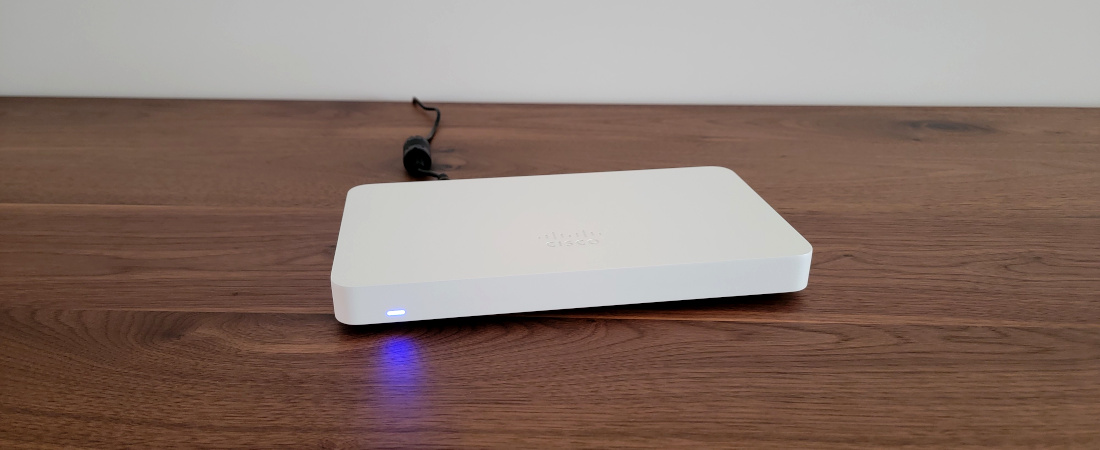TechRadar Verdict
The Meraki Go Plus hardware firewall is excellent at securing a small business network quickly and effectively. For $340, the built-in software includes Cloud connectivity, VPN, IP filters, and something that is still uncommon but extremely useful, network analytics. Being a Cisco product, the Go Plus takes advantage of great online support backed with a two-year warranty.
Pros
- +
Low power
- +
Network analytics
- +
Powerful CPU
Cons
- -
Non-functional USB port
Why you can trust TechRadar
The Meraki Go Router Firewall Plus is a compact router with an integrated firewall, comparable to more expensive products but for a fraction of the price. The Go Plus is fast to get up and running using the mobile app. Out of the box, the transfer rate with packet filtering is a decent 500Mbps across all four ports. Even better is the slew of software features, such as VPN and cloud access, provided for free.
The Meraki Go has four 1Gb Ethernet ports for local access and another 1Gb dedicated to the Internet. The included USB port can only be used as a power source for small devices, while a multicolored LED on the front shows the progress of the router’s internal operations. The unit comes with a limited two-year warranty.
Meraki Go: Price and availability
There are presently two versions of the Meraki Go. The Plus, which costs $340, stands out by being fast at processing Internet packets. For $130, the Meraki Go provides the same feature and comes with Power over Ethernet but has a slower processor.

Meraki Go: Design
The Meraki Go Plus comes well-packed, with the main unit and accessories stored in two separate cardboard trays. Two RJ45 Ethernet cables, a 30W 12V AC power block, and wall mount screws are all provided to make installation as smooth as possible. Instead of providing a user manual, Meraki gives a URL and QR code printed on a small business card where the user can get the complete installation procedure.
The Go Plus is a plain white metal box with the Cisco logo engraved on the top. It can be placed flat on a table or vertically on a wall using two screw slots at the back. A single LED acts as a multifunction status indicator on the front, while a Kensington lock slot on the left prevents the removal of the unit. The back of the case holds all network connections and a 12V power input. Two green LEDs showing link-up and activity are placed above each RJ45 ethernet socket.
Under the hood, the Meraki Go Plus sports a Freescale Quad-core ARM CPU clocked at 1.6GHz. The amount of memory is also remarkable for a router/firewall of this size, with 4GB of DDR and 1GB of flash memory. All active components are passively cooled. The Meraki Go consumes less than 4W when idle and 14W using all ports and features. A reset button next to the power jack allows for restoring the device’s factory settings when things no longer work.
A multicolored front LED shows the device’s status. Orange indicates that the unit is disconnected from the cloud, while rainbow shows that the box is attempting a cloud connection. The firewall performs its firmware upgrade when the LED flashes white, and a solid white means the firewall is connected and fully operational.

Meraki Go: In use
Configuration of the Meraki Go firewall is performed using the mobile application, which is available for Apple and Android platforms. The first step is registering the device by scanning a QR code at the back of the firewall. For this to work, the device must have access to the Internet through the WAN port. The Meraki Go Plus boots within one minute.
The firewall’s software supports several features, including VPN and client filtering. The user usually uses VLANs to isolate different networks to secure infrastructure. The Go Plus can connect over 50 clients simultaneously without speed degradation using VLANs. On top of supporting packet filtering based on ports and IP addresses, the user can use two connected Meraki firewalls to create a site-to-site VPN, ensuring end-to-end privacy.
Meraki Go offers free cloud connectivity from the get-go. The user can view and control the firewall wherever an Internet connection is available, either from a web browser or the Meraki mobile app.
A nifty feature of the Meraki Go Plus is its ability to view connected users’ trends. For this, the firewall records connection times, IPs, and the busiest time of the day. This data can help business owners understand their customers’ needs and see potential infrastructure problems before it even happens, such as network congestion during peak hours.

Meraki Go: The competition
A firewall/router combo is a handy device that helps secure a public network quickly while offering control and visibility over connected clients.
Firewalla’s Gold firewall provides similar performance to the Go Plus. The small form factor is also comparable to Meraki’s unit, and with an MSRP of $485, the Gold is more expensive by $100. The Gold also has fewer Gigabit ports, with only four, including the WAN port, compared to five for Meraki. It also has a higher power specification, being based on a more powerful CPU.
Meraki Go: Final verdict
The Meraki Go Plus shines with its discrete and modern design. The hardware performs one task to perfection: filter network packets as quickly as possible. It comes with plenty of software options that will smoothly transition the owner from an unsecured network to one that will withstand many common network attacks. On top of having the basic IP and MAC filtering, the Guest Insights feature brings advanced network analytics to neophytes.
Since Meraki is a Cisco brand, the hardware costs more than similar firewalls. It also feels like the hardware could handle more tasks, one where the USB port could be leveraged and do backups to an external drive.
We've listed the best wireless routers.
My interest has been piqued by everything electronic since a young age, with a penchant for the dark art of tearing things apart. My daily duty is to marry software and hardware modules and I have to admit that this is much harder than cooking. When I’m not busy at work, I’m on the lookout for the latest and greatest hack! I am passionate about portable power generators (or power stations) as well as maker products such as the Raspberry Pi and any similar SBC (single board computers)

